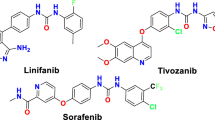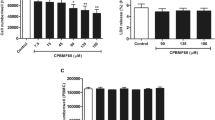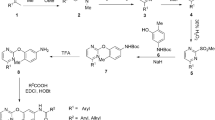Abstract
Hepatocellular carcinoma (HCC) is one of the most common cancers worldwide and the third most common cause of cancer-related deaths. The objective of our research was to develop effective agents against HCC. Here, we have synthesized a series of anilinoquinoline derivatives. Based on a MTT assay and qRT-PCR in human Huh-7 hepatoma cells, we observed that 2-(2,6-dimethylanilino)quinoline (9) and 2-(3-benzenecarbonylanilino)quinoline (23) exhibited good antitumor activity. Besides, the polo-like kinase 1 (PLK1) positively correlated with aggressiveness of tumors and polo-like kinase 3 (PLK3) regarded as a tumor suppressor gene are serine/threonine kinases that play an essential role in carcinogenesis. Our results indicated that 2-anilinoquinoline (6) and 2-(3,5-dimethoxyanilino)quinoline (16) may decrease the expression levels of PLK1 gene, as well as increase the expression levels of PLK3 gene. We suggested this series of synthesized anilinoquinolines be promising to develop as novel regulating PLK molecular. Further, structural modification and the molecular mechanism of these compounds as a candidate are underway.



Similar content being viewed by others
References
Bennett GM, Crofts PC, Hey DH (1949) Synthetic antimalarials. Part XXXV. Further arylaminodialkylaminoalkylaminoquinoline derivatives. J Chem Soc 227–232. doi:10.1039/JR9490000227
Bradley W, Wright I (1956) Metal derivatives of N,N′-diarylamidines. J Chem Soc 640–648. doi:10.1039/JR9560000640
Broch S, Aboab B, Anizon F, Moreau P (2010) Synthesis and in vitro antiproliferative activities of quinoline derivatives. Eur J Med Chem 45:1657–1662
Chang FS, Chen W, Wang C, Tzeng CC, Chen YL (2010) Synthesis and antiproliferative evaluations of certain 2-phenylvinylquinoline (2-styrylquinoline) and 2-furanylvinylquinoline derivatives. Bioorg Med Chem 18:124–133
Conn CW, Hennigan RF, Dai W, Sanchez Y, Stambrook PJ (2000) Incomplete cytokinesis and induction of apoptosis by overexpression of the mammalian polo-like kinase, Plk3. Cancer Res 60:6826–6831
Degenhardt Y, Lampkin T (2010) Targeting polo-like kinase in cancer therapy. Clin Cancer Res 16:384–389
Kuo SC, Lee HZ, Juang JP, Lin YT, Wu TS, Chang JJ, Lednicer D, Paull KD, Lin CM (1993) Synthesis and cytotoxicity of 1,6,7,8-substituted 2-(4′-substituted phenyl)-4-quinolones and related compounds: identification as antimitotic agents interacting with tubulin. J Med Chem 36:1146–1156
Lu CM, Chen YL, Chen HL, Chen CA, Lu PJ, Yang CN, Tzeng CC (2010) Synthesis and antiproliferative evaluation of certain indolo[3,2-c]quinoline derivatives. Bioorg Med Chem 18:1948–1957
Mancuso A (2010) Hepatocellular carcinoma in thalassemia: a critical review. World J Hepatol 2:171–174
Molina P, Alajarin M, Vidal A, Sanchez-Andrada P (1992) C=C-Conjugated carbodiimidazoles as 2-azadienes in intramolecular [4 + 2] cycloadditions. One-pot preparation of quinoline, α-carboline, and quinindoline derivatives. J Org Chem 57:929–939
Musiol R, Jampilek J, Buchta V, Silva L, Niedbala H, Podeszwa B, Palka A, Majerz-Maniecka K, Oleksyn B, Polanski J (2006) Antifungal properties of new series of quinoline derivatives. Bioorg Med Chem 14:3592–3598
Musiol R, Jampilek J, Kralova K, Richardson DR, Kalinowski D, Podeszwa B, Finster J, Niedbala H, Palka A, Polanski J (2007) Investigating biological activity spectrum for novel quinoline analogues. Bioorg Med Chem 15:1280–1288
Naik MU, Naik UP (2011) Calcium- and integrin-binding protein 1 regulates microtubule organization and centrosome segregation through polo like kinase 3 during cell cycle progression. Int J Biochem Cell Biol 43:120–129
Newman DJ, Cragg GM (2007) Natural products as sources of new drugs over the last 25 years. J Nat Prod 70:461–477
Olsen SK, Brown RS, Siegel AB (2010) Hepatocellular carcinoma: review of current treatment with a focus on targeted molecular therapies. Therap Adv Gastroenterol 3:55–66
Pellegrino R, Calvisi DF, Ladu S, Ehemann V, Staniscia T, Evert M, Dombrowski F, Schirmacher P, Longerich T (2010) Oncogenic and tumor suppressive roles of polo-like kinases in human hepatocellular carcinoma. Hepatology 51:857–868
Peng HK, Lin CK, Yang SY, Tseng CK, Tzeng CC, Lee LC, Yang SC (2012) Synthesis and anti-HCV activity evaluation of anilinoquinoline derivatives. Bioorg Med Chem Lett 22:1107–1110
Priya N, Gupta A, Chand K, Singh P, Kathuria A, Raj HG, Parmar VS, Sharma SK (2010) Characterization of 4-methyl-2-oxo-1,2-dihydroquinolin-6-yl acetate as an effective antiplatelet agent. Bioorg Med Chem 18:4085–4094
Ramesh E, Manian RDRS, Raghunathan R, Sainath R, Raghunathan M (2009) Synthesis and antibacterial property of quinolones with potent DNA gyrase activity. Bioorg Med Chem 17:660–666
Strebhardt K (2010) Multifaceted polo-like kinases: drug targets and antitargets for cancer therapy. Nat Rev Drug Discov 9:643–660
Strebhardt K, Ullrich A (2006) Targeting polo-like kinase 1 for cancer therapy. Nat Rev Cancer 6:321–330
Vázquez MT, Romero M, Pujol MD (2004) Synthesis of novel 2,3-dihydro-1,4-dioxino[2,3-g]quinoline derivatives as potential antitumor agents. Bioorg Med Chem 12:949–956
Venkatesh C, Sundaram GSM, Ila H, Junjappa H (2006) Palladium-catalyzed intramolecular N-arylation of heteroarenes: a novel and efficient route to benzimidazo[1,2-a]quinolines. J Org Chem 71:1280–1283
Wang Q, Xie S, Chen J, Fukasawa K, Naik U, Traganos F, Darzynkiewicz Z, Jhanwar-Uniyal M, Dai W (2002) Cell cycle arrest and apoptosis induced by human polo-like kinase 3 is mediated through perturbation of microtubule integrity. Mol Cell Biol 22:3450–3459
Weerdt BC, Medema RH (2006) Polo-like kinases: a team in control of the division. Cell Cycle 5:853–864
Yang Y, Bai J, Shen R, Brown SA, Komissarova E, Huang Y, Jiang N, Alberts GF, Costa M, Lu L, Winkles JA, Dai W (2008) Polo-like kinase 3 functions as a tumor suppressor and is a negative regulator of hypoxia-inducible factor-1α under hypoxic conditions. Cancer Res 68:4077–4085
Zhu AX (2010) Systemic treatment of hepatocellular carcinoma: dawn of a new era? Ann Surg Oncol 17:1247–1256
Acknowledgments
Financial support of this work by the National Science Council of Taiwan is gratefully acknowledged. We also thank the National Center for High-Performance Computing for providing computer resources and chemical database services. This work was supported by the National Science Council of Taiwan (Grant Number: NSC96-2745-M-037-003-URD and NSC98-2119-M-037-001-MY3), Cancer Center, Kaohsiung Medical University Hospital, Taiwan (Grant Number: DOH100-TD-C-111-002), and Center of Excellence for Environmental Medicine, Kaohsiung Medical University, Taiwan (Grant Number: KMU-EM-99-5-1).
Conflict of interest
The authors declare that they have no conflict of interest.
Author information
Authors and Affiliations
Corresponding authors
Additional information
Huang-Kai Peng and I-Ling Lin contributed equally to this work.
Rights and permissions
About this article
Cite this article
Peng, HK., Lin, IL., Lee, CC. et al. Synthesis and antitumor activity evaluation of anilinoquinoline derivatives by the effect on the expression of polo-like kinase. Med Chem Res 23, 1437–1446 (2014). https://doi.org/10.1007/s00044-013-0749-3
Received:
Accepted:
Published:
Issue Date:
DOI: https://doi.org/10.1007/s00044-013-0749-3




